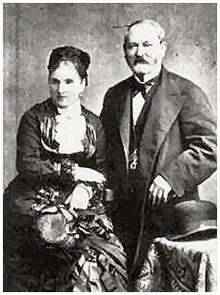Gustav Fabergé

Gustav Fabergé born 1814 in Pernau – 1893 in Dresden, was a Baltic German jeweller and father of the famous Peter Carl Fabergé, maker of Fabergé eggs. He established his own business in Saint Petersburg, which his son inherited.
Life and career
Gustav Fabergé, a Baltic German, was born in the city of Pernau (now Pärnu) in Livonia (present-day Estonia). His father, the artisan Pierre Favry (1768–1858) (later Fabrier) moved to the Baltic province of Livonia, then part of the Russian Empire. Pierre had moved there by 1800 from the German city of Schwedt an der Oder. He married a Silesian merchant’s daughter called Maria Louisa Elsner (1776–1855). His family were Huguenots from Picardy living in Germany, having fled religious persecution in France at the end of the 17th century after the revocation of the Edict of Nantes. In 1796 he registered as a master joiner in Pärnu under the names of Peter Fabrier in 1796) and Peter Faberg in 1808. Their son Gustav was born in Pärnu, where he adopted the surname of Faberge in 1828. Gustav apprenticed to Andreas Ferdinand Spiegel in St Petersburg. He then worked for Johann Wilhelm Keibel in the 1830s. Gustav qualified as a master in 1841. In 1842 he opened the jewellery firm House of Fabergé in Saint Petersburg and got married to Charlotte Maria Fabergé born Jungstedt, the daughter of a Danish artist. He employed Johann Alexander Gunst, Johann Eckhardt and since 1857 August Wilhelm Holmström. [1]lPeter Carl Fabergé was initially educated in St Petersburg. In 1860, Gustav Fabergé, together with his wife and son retired and moved to Dresden, leaving the business in the hands of Peter Hiskias Pending and V. A. Zaianchkovski. In Dresden they lived at Walpurgisstraße and Victoriastraße, a few minutes walk from the Castle and the famous jewelry collection Grünes Gewölbe with the important jewelry of Johann Melchior Dinglinger.[2] Peter Carl continued his education in Dresden. A second son, Agathon, was born to the couple two years later. [3]
In 1864 Peter Carl Fabergé embarked upon a Grand Tour of Europe. He received tuition from respected goldsmiths in Germany, France and England, attended a course at Schloss’s Commercial College in Paris and viewed the objects in the galleries of Europe’s leading museums. He returned to St Petersburg and married Augusta Julia Jacobs. For the following 10 years, his father’s trusted work master Peter Hiskias Pendin acted as his mentor and tutor. Upon Pendin's death in 1882 Peter Carl took over the business and was joined by his brother Agathon Fabergé. Gustav Fabergé lived in Dresden with his wife until both of them passed away in 1893. He was cremated in Gotha and is buried next to his wives remains at Trinitatisfriedhof cemetery in Dresden. [4] A grave stone does not exist anymore. [5] [6] [7] [8] [9] [10] [11] [12]
Statue in Pärnu
Gustav Fabergé monument was opened in Pärnu on January 3, 2015 in the year of the bicentenary of his birth. The bronze statue is a gift to the city from Alexander Tenzo, the founder of TENZO jewellery house. Composition authors Alexander Tenzo and Vladislav Yakovsky. Sculptor Eugeny Burkov. The statue was mounted with support of the City Government of Pärnu and Pärnu Fabergé Society represented by Tiina Ojaste and Toomas Kuter.[13]
References
- ↑ http://www.beyars.com/kunstlexikon/lexikon_2707.htm
- ↑ http://saebi.isgv.de/biografie/Agathon_Fabergé_(1862-1895)
- ↑ http://www.rusartnet.com/biographies/russian-artists/19th-century/mid-19th-century/rossica/french/gustav-faberge
- ↑ https://www.findagrave.com/memorial/129230127/peter_gustav-fabergé#source
- ↑ https://www.bild.de/regional/dresden/kuenstler/geheim-grab-der-faberge-entdeckt-35818942.bild.html
- ↑ H. C. BAINBRIDGE, Peter Carl Fabergé, London 1949 (Neudr. 1966, 1974)
- ↑ G. v. HABSBURG-LOTHRINGEN, C. F. Die glanzvolle Welt eines königlichen Juweliers, in: DU Europäische Kunstzeitschr., Nr. 442, Dez. 1977, S. 51 ff.
- ↑ G. v. HABSBURG-LOTHRINGEN, A. v. SOLODKOFF, F. Court Jeweler to the Tsars, Fribourg 1979 (Neudr. 1984), dt. Ausg. 1979
- ↑ A. K. SNOWMAN, C. F., Goldsmith to the Imperial Court of Russia, London 1979
- ↑ H. WATERFIELD, C. FORBES, C. F. Imperial Easter Eggs and Other Fantasies, New York 1978, London 1979
- ↑ A. v. SOLODKOFF, Masterpieces from the House of F., New York 1984
- ↑ G. v. HABSBURG, F. Hofjuwelier der Zaren, Kat. d. Bayer. Nat. Mus. und der Kunsthalle d. Hypo-Kulturstiftung München, München 1986/87.
- ↑ Teet Roosaar. Pärnut ehib Gustav Fabergé pronkskuju. Pärnu Postimees, January 6, 2015 (No. 2), p. 1.